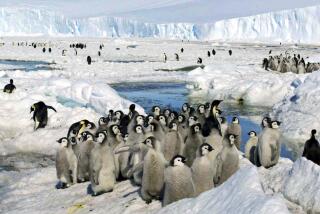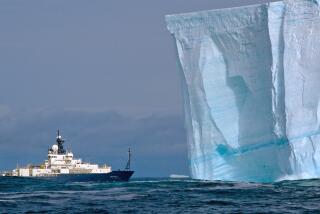A place of beauty on, and under, the icy sea
- Share via
We were so entranced by the wall of fluted ice at our fingertips that we never saw the dark shadow behind us. Slowly it grew closer, emerging out of the dusky blue and stopping behind our backs. One of the divers happened to turn around, and there, inches from his mask, was a set of furry nostrils.
A leopard seal. It wasn’t our first. They had been with us almost from the moment we hit the water in Antarctica. We had hoped to see them perhaps once during our trip. Who knew they’d show up on nearly every dive?
Leopard seals get their name from their spots — and their vicious, predatory nature. But their customary prey is penguins, not people. On that dive, the huge old bull circled curiously, spiraling ever closer until his face was hardly a foot from mine. I could count the hairs on his cheeks. He poked his nose practically into my mask, darting forward in a feint that dive guide Adam Rheborg later explained was not so much a threat as a signal, “Hey, I’m bigger than you.” And he certainly was.
Dive leader Goran Ehlme, who once spent a summer filming leopard seals, said he nearly had a stroke the first time one of them pulled that nose-in-your-face trick. But he realized they wanted to play and, in fact, he so bonded with one female that by the end of the season, she was nuzzling his neck and bringing him half dead penguins as gifts.
I’m not sure what our group of divers expected to find underwater in Antarctica. A bit of soft coral, perhaps. Some sponges, some starfish and maybe a glimpse of penguins swimming by.
But no one expected the leopard seals. Or the sheer beauty of the ice, not to mention brilliant topside scenery. We would slide into the water and spend 30 to 40 minutes. When we came up, we’d see a wall of snowy rock, fissured glaciers flowing to the waterline and huge towers of ice that sometimes collapsed before our eyes. The ice was bigger, bolder, flatter than in Arctic regions. Chunks of glacier the size of houses or entire city blocks cleaved off and floated like steroidal ice cubes.
We were there in late February, almost the end of the austral summer, and fresh snow dusted the mountains.
The farther south we went, the colder it got. The 45-degree temperatures of South America gave way to freezing the moment we crossed the 60th parallel. By the time we hit the Antarctic Circle — 66.5 degrees south — we were in gale-force winds. But most of the time, it was sunny, if not particularly warm.
Underwater, the temperatures hovered at 32, sometimes sinking to 28. (Salt water can stay liquid below the freezing point for non-saline water).
We had left Ushuaia, Argentina, at the southern tip of an island off the southern end of South America, on Feb. 28 and, after two days crossing the Drake Passage, reached the Antarctic Peninsula. We spent a week there, traveling along the peninsula to the Antarctic Circle and doing two dives a day. But there was also much to see on land. It always came down to a choice — dive or hike.
All 15 divers played hooky to visit Neko Harbour, one of the few penguin colonies that had chicks so late in the season. It also offered our only chance to set foot on the Antarctic mainland rather than an offshore island. The birds spread across a rising slope of snow that was furrowed with ditches worn by thousands of penguin feet.
It was almost too good to be real, with obliging penguins on the beach — some sunning themselves, some preening, many molting, with patches of down still fluffing across their bodies. Adolescent chicks chased moms for food. Two Weddell seals lay on the beach, and a leopard seal lurked just offshore. More penguins swam across the glass-smooth water. Behind them, walls of ice rose in cracked columns that avalanched regularly, sometimes bringing down a hundred-foot-wide face.
As the setting sun turned the snow gold and then pink, we motored in Zodiacs to the far end of the bay, where three humpback whales floated. They blew clouds of fishy breath our way and rumbled like elephants. They were so close, we could count the bumps on their noses.
Underwater life
OF course, there were more things to see under water than ice and leopard seals: submerged wrecks, blades of kelp a yard wide, walls packed with marine life. We made an ice dive at Pleneau Island in a graveyard of ice chunks. Some of them were bigger than houses, but they were grounded so there was no danger of their rolling over on us.Amazingly, Antarctic tourism has made scuba trips almost routine. It’s been less than 40 years since the first cruise ship began unloading wealthy tourists at penguin rookeries. Even 10 years ago, a simple cruise here was the ultimate in exotic.
Now there are companies that take skiers to the South Pole, climbers to interior peaks and kayakers to the peninsula. Several companies offer scuba diving. Last season alone brought 13,571 tourists to Antarctica, according to statistics compiled by the International Assn. of Antarctica Tour Operators. However, it is estimated that fewer than 500 made it to the Antarctic Circle.
The vessels in Antarctica these days range from tiny sailing ships to 1,300-passenger behemoths complete with casinos, night club acts and midnight buffets. But most Antarctic tourism is done aboard decommissioned Russian research ships with ice-hardened or ice-breaking hulls and relatively small numbers of passengers (50 to 90), along with rugged itineraries that include hiking, kayaking and scuba diving.
Most tourists visit the Antarctic Peninsula, a long, jutting finger of land that brings Antarctica within a two-day sail of South America and has relatively hospitable weather (meaning temperatures around 40 or so) during the austral summer (December through early March).
Tourist conduct is governed by rules laid down by the tour operators’ association, a Colorado-based trade group with 32 member companies. You don’t go closer than 15 feet to the penguins (though they are allowed to approach, nibble, etc. you). You don’t go closer than 45 feet to fur seals because they can get aggressive. You don’t leave anything behind.
And although there was a period in the early 1990s when tourists were decidedly unwelcome at some research stations because the numerous visits disrupted work, that has changed, especially at smaller stations run by smaller nations that rely heavily on tourist dollars for funding.
At Vernadsky, a Ukrainian station taken over from the United Kingdom for a pound sterling (the actual coin is embedded in wood at the station bar), we learned the average temperature here has risen five degrees Fahrenheit in the last 60 years. The scientists at Vernadsky love tourists. The newly arrived winter-over crew explained that in two weeks, five ships visited, dropping $2,000 for such souvenirs as pins, T-shirts, cold weather gear and maps. During peak season, two ships a day visit. It helps pay the bills.
Nearby we found the original British station, now a museum, left as it was in the 1940s. The pantry is stocked with old packs of biscuits, tins of Art Deco tuna and an ancient can of Ovaltine along with original typewriters, slide rules, goggles and crampons.
The resident biologists at Port Lockroy don’t sit idle between the 100 or so visits they receive each year (we were ship No. 93 of the season). One recent project involved studying tourist visits and Gentoo penguin hatchings. They divided a nearby island into visited and unvisited areas and then sat back to see what happened.
Curiously, said Amanda Lynnes, a British penguin biologist, the eggs were found to be slightly more successful in the visited area. The working theory: Tourists scared off the predatory skua seabirds. And although there are those who would like to close Antarctica to tourism or, at least, severely limit the number of visitors, many researchers think the visits do no harm. They attribute this, mostly, to the strict rules.
“When you land at Goudier Island [with Port Lockroy one of the most visited spots in Antarctica], just imagine the number of people who have been there before you — probably 6,000 this season alone — and just have a look,” said Pete Milner, one of the two researchers manning Port Lockroy.
“There’s no litter, the water is completely clean. This is because people adhere to the environmental standards for tourism. And it’s important for people to see what is effectively the last pristine wilderness we’ve got. There isn’t one after this. If we mess up this one, it’s too late.”
*
(BEGIN TEXT OF INFOBOX)
Seeing the seals
GETTING THERE:
Most trips depart from Ushuaia, Argentina, and run 12 days, with a two-day crossing of the Drake Passage to the Antarctic Peninsula, about a week traveling along the peninsula and two days back. Most dive trips use former Russian research ships, all of which are about 200 feet long and carry 45 to 50 passengers. On our trip, there were 15 divers and 30 hikers.
Cruises to Antarctica take place during the austral summer, from December to mid-March. Most dive trips run late in the season, when there is a better chance of seeing leopard seals.
Antarctic dive trips are not for novice divers because they involve diving in extremely cold water and the use of dry suits and other cold water gear.
Trips run from about $5,000 to more than $8,000 depending on cabin.
DIVE TRIPS:
Oceanwide Expeditions, 15710 JFK Blvd., Suite 285, Houston, TX 77032; (800) 453-7245, https://www.oceanwide-expeditions.com . One scuba trip is scheduled Feb. 16-27; next year three are planned. Prices this year range from $5,490 to $6,900; non-scuba passengers pay $800 less.
Quark Expeditions Inc., 980 Post Road, Darien, CT 06820; (800) 356-5699, https://www.quarkexpeditions.com . Two trips are planned this season, Feb. 8-19 and Feb. 18-29, with three planned the next year. Prices this year range from $4,595 to $7,895; non-scuba passengers pay $600 less.
Aurora Expeditions, 182A Cumberland St., The Rocks, NSW 2000, Australia; 011-61-2-9252-1033, https://www.auroraexpeditions.com.au . The dive trip this season has already run, but trips are planned for Feb. 16-27, 2005, and late 2005-early 2006. Prices next year start at $4,690; non-divers pay $500 less.
TO LEARN MORE:
IATTO, P.O. Box 2178, Basalt, CO 81621; (970) 704-1047, https://www.iaato.org
Another excellent resource is “Antarctica,” by Jeff Rubin (Lonely Planet, $19.99).
— Yvette Cardozo
More to Read
Sign up for The Wild
We’ll help you find the best places to hike, bike and run, as well as the perfect silent spots for meditation and yoga.
You may occasionally receive promotional content from the Los Angeles Times.






